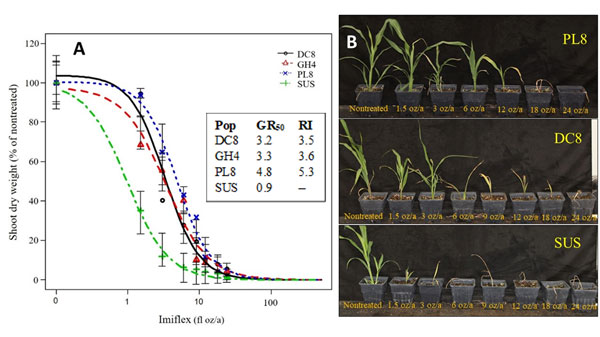Shattercane is a summer annual grass weed species commonly present in grain sorghum producing regions, including Kansas. Shattercane is closely related to grain sorghum and can exchange genes through crossing and hybridization. If left uncontrolled, season-long infestation of shattercane can cause >95% yield reductions in grain sorghum.
Sorghum hybrids (igrowth® and Inzen™) with tolerance to ALS inhibitors such as imazamox (IMIFLEX™ herbicide) and nicosulfuron (Zest™ WDG herbicide) have recently been developed. Both Inzen™ and igrowth® sorghum will allow producers to use POST applications of ALS inhibitors (Zest™ WDG on Inzen™ and IMIFLEX™ on igrowth® sorghum) for grass weed control. However, it is important to note that shattercane is NOT included on either the IMIFLEX™ or Zest™ labels. For the 2021 growing season, igrowth® sorghum will be available for commercial production, while Inzen™ sorghum will be available with a limited seed supply. Double Team™ sorghum with tolerance to quizalofop-p-ethyl (FirstAct™ herbicide) will also be available for selected fields for the 2021 growing season.
A field survey sponsored by the United Sorghum Checkoff was initiated in fall of 2020 for seed collection of shattercane and Johnsongrass populations to better understand their sensitivity to IMIFLEX™, Zest™, and FirstAct™ herbicides. In a preliminary greenhouse study, three different shattercane populations collected from three different counties (Decatur, Graham, and Phillips) in northwest Kansas survived the field-use rate (6 fl oz/a) of POST applied IMIFLEX™ herbicide, indicating a suspected resistance to imazamox.
Greenhouse study on imazamox-resistant shattercane
Dose-response experiments were conducted at the K-State Agricultural Research Center in Hays, KS to confirm the levels of resistance to IMIFLEX™ in the same three shattercane populations identified in the preliminary study mentioned above. Additionally, seeds of a previously known susceptible shattercane population that were originally collected from a sorghum field in Rooks County, KS were used. The IMIFLEX™ herbicide doses of 0, 1.5, 3, 6, 9, 12, 18, and 24 fl oz/a were tested on 3 to 4-leaf stage of shattercane seedlings. Results indicated that the all three suspected populations had a 3.5- to 5.3-fold resistance to IMIFLEX™ herbicide as compared to the susceptible population (Figure 1).
Response of imazamox-resistant shattercane to alternative herbicides
A separate greenhouse study also evaluated all four shattercane populations with alternative herbicides such as Zest™ (nicosulfuron) at 0.9 oz/a, Aggressor™ (quizalofop-p-ethyl) at 8 fl oz/a, Select Max® (clethodim) at 10 fl oz/a, and Roundup PowerMax® (glyphosate) at 32 fl oz/a. All four herbicides provided an excellent control (95 to 100% control at 3 weeks after treatment) of all four shattercane populations.

Figure 1. Shoot dry weight (A) and visual injury (B) response of four shattercane populations (DC8, GH4, PL8, and SUS) in a dose-response study with IMIFLEX™ herbicide at 3 weeks after treatment. Photos by Vipan Kumar, K-State Research and Extension
*GR50 value is the effective dose (fl oz/a) of IMIFLEX™ herbicide needed for 50% reduction in shoot dry weights of each shattercane population. RI (Resistance Index) is the ratio of GR50 value of each resistant population to that of GR50 value of susceptible population.
Summary
Although only three shattercane populations have thus far been confirmed and characterized, it is concerning that all three populations showed low-to-moderate resistance to imazamox in Kansas. Herbicide screening of additional shattercane and Johnsongrass populations collected from a 2020 sorghum field survey in western Kansas is still underway. These results will be shared with producers as they become available.
Evolution of imazamox-resistant shattercane would be a serious concern, especially for a newly developed igrowth® sorghum. Sorghum producers are advised to adopt proper IMIFLEX™ use stewardship guidelines if they are planning to plant igrowth® sorghum this summer and are encouraged to utilize alternative herbicides in conjunction with other cultural and mechanical practices to prevent the evolution of imazamox-resistant shattercane on their production fields. In addition, check herbicide labels for specific grasses listed for control.
Brand names appearing in this publication are for product identification purposes only. No endorsement is intended, nor is criticism implied of similar products not mentioned. Persons using such products assume responsibility for their use in accordance with current label directions of the manufacturer.
Vipan Kumar, Weed Scientist, Agricultural Research Center-Hays
vkumar@ksu.edu
Brent Bean, Agronomist, United Sorghum Checkoff Program